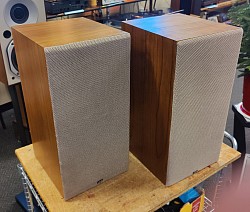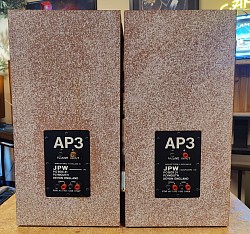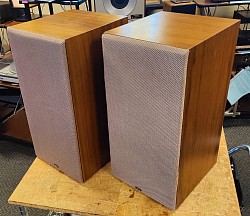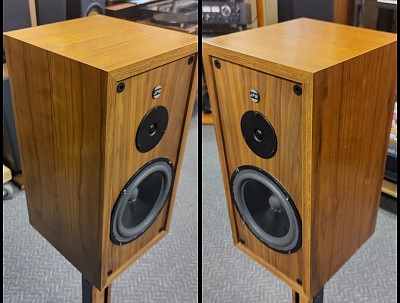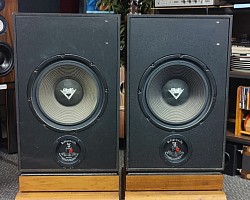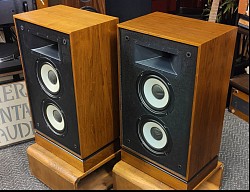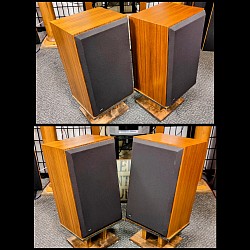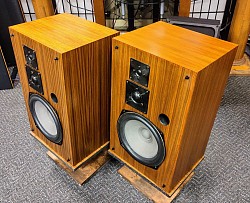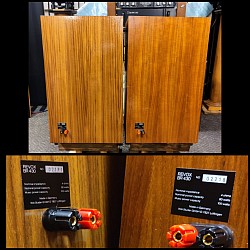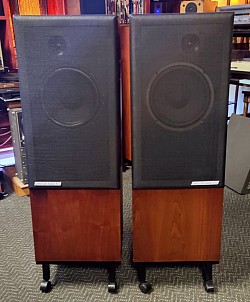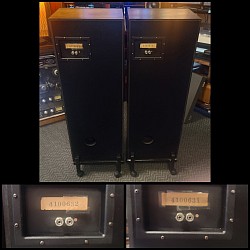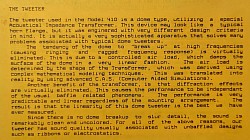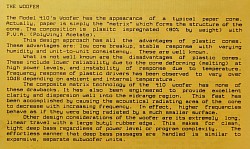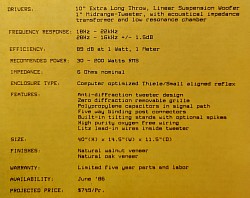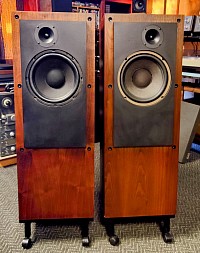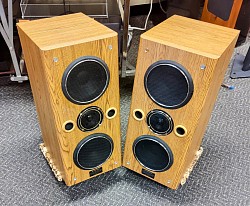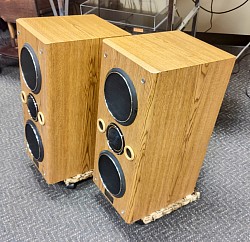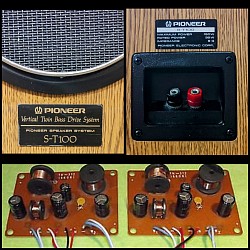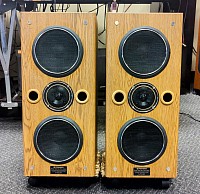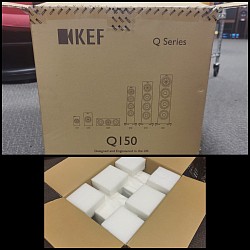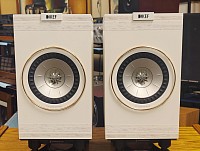Page 2 Stereo Speaker Systems
JPW AP-3
(England '86-'93) SOLD (rare, pristine)
Not often seen on this side of the "pond", this pair of JPW AP-3 speakers are in mint cosmetic and working condition. The original boxes and packing materials are included. The exterior cabinet construction is absolutely stunning...there is more detailed info below.
Although JPW is practically unheard of in the Americas, their limited production models have a loyal following in Europe. The AP-3 was their premium model at the time of release.
The AP-3 is a true (although pretty heavy at 27 lbs) bookshelf speaker system featuring a fully timber-veneered cabinet. The main driver is an 8" woofer with an unusual diecast basket and 25 mm diameter long-throw voice coil manufactured by Vifa in Denmark. This driver is mounted in a sealed, solidly constructed enclosure of 18 mm thick double-veneered particle board.
NOTE: This driver is identical to those used in Heybrook HB1, JPW P1, JPW AP2, JPW AP3, certain Infinity models and Snell type K systems. Direct replacements are still available and badged as either Vifa or Scanspeak.
The inside of the enclosure incorporates a 25 mm thick low density bonded acetate absorptive lining with a five element pi filter crossover mounted on the rear panel. This crossover operates at 2250 Hz to feed an unusual 19 mm diameter soft dome tweeter in which ferro fluid is used in the air gap for power handling enhancement. This tweeter was also manufactured by Vifa.
The cabinet is very well made and the front escutcheon features a neatly fabricated molded hardboard frame with plastic retention caps surmounted by a dark brown open weave speaker cloth. The rear of the cabinet is painted and incorporates a pair of color-coded universal terminals and a uniquely separate set of connections for bi-wiring on the back panel.
Some 19th century British political observer mused that the sun never set on the British Empire. But came the day that it did and Britain's military, industrial and commercial might collapsed like a blimp with a leak. These days however, if you look into the world of British hi-fi, you get the distinct impression that it's "The Empire Strikes Back". JPW joined the intergalactic fleet with a weapon that just might have some impact; the JPW AP-3.
In terms of the so-called "British" sound, it's easier to relate to the East Coast sound (Advent, etc) vs the West Coast sound (JBL, etc) right here in the good old USA. Closer to the East than the West, the AP-3 are perfect for jazz, classical, vocals; however, the bass is more than satisfactory.
Basically, JPW AP-3 can be regarded as a typical British sound, especially the sound of the early Linn LP-12. In other words, the middle and high notes are warm and slightly dark, and the mid-low frequency is full and slightly expanded. In the performance of AP-3, the middle and high notes and above are indeed warm and sweet and full of musical sense. Come to think of it, trying to describe them is fruitless. Let your ears decide.
Specs:
8 ohms
8" Vifa mid-bass drivers
0.8" Vifa tweeters (ferrfo-fluid)
Bi-amp capable
Max Power: 100 watts
Dimensions: 10.25"W x 11.5"D x 20.5"H
Weight: 27 lbs each
About JPW...
JPW is another British company to join the illustrious group of manufacturers who are all leaving their 'veritable mark' on the world of high fidelity. JPW ís a very small firm with an equally small product range. The managing director of JPW is also its founder, an engineer by the name of Peter Wanstall, a self-confessed hi-fi addict who has produced his own speakers and amplifiers for some years. Since 1978 JPW has been actively producing products for the British market and recently branched into the export field.
For a more in-depth history of the players involved in JPW, go here:
https://youtu.be/JBwi7jnDGcA
v=JBwi7jnDGcAhttp://www.revolveraudio.co.uk/about_us.htm
++++++++++++++++++++++++++++++++++++++++++
++++++++++++++++++++++++++++++++++++++++++
Klipsch KG-4
('85-'92) $600
In excellent cosmetic condition and fully operational, this pair of Klipsch kg4 has all 100% original drivers, crossovers, grills and badges. This pair has the very desirable walnut enclosures. They have been lightly sanded and refinished.
Similar to a dipole construction, the twin 8" mid-bass drivers and horn tweeter in front are complemented by a 12" passive radiator on the back. With that design you can expect that bottom end to drop down to about 20kHz. With sensitivity at 94dB, the KG-4 will do just fine with a wide variety of most mid-to-high quality amps.
The best description from HiFi Classic:
https://www.hifi-classic.net/review/klipsch-kg4-550.html
"The Klipsch kg4 is a two-way floor-standing speaker system featuring unusually high efficiency (for a home speaker) combined with an extended, smooth frequency response. Its handsomely finished walnut enclosure is 24.25" high, 15.75" wide, and 10.75" deep, and the system weighs 45 pounds each. The dark brown, wood-framed cloth grille is retained by strong plastic fasteners.
The front panel of the kg4 contains two white plastic-cone woofers, one above the other, with a nominal diameter of 8". At the top of the panel is a horn-loaded tweeter—a device unusual in home speakers—with mouth dimensions of 8.5" x 3". The crossover frequency is 1,800 Hz.
On the rear panel of the enclosure is a 12" passive cone radiator that extends the low-frequency response limits of the smaller bass drivers. The binding-post terminals, recessed into the rear of the cabinet, accept banana plugs, including dual plugs on 3/4" centers, as well as wires. There are no external controls or adjustments."
Complete specs:
Frequency response: 38Hz-20kHz
Sensitivity: 94dB
Power handling: 100 watts maximum continuous (500 watts peak)
Impedance: 6 ohms
Tweeter: K-74-K 1″ Phenolic dome compression driver
High frequency horn: 90(o)x40(o) Exponential Horn
Woofer: Two K-8-K 8″ (20.32cm) Poly ICG cone active / KD-12 12″ (30.48cm) Fiber-composite cone passive
Enclosure material: Medium density fiberboard construction (MDF)
Enclosure type: Bass reflex via passive radiator
Dimensions: 24.25″H x 15.75″W x 10.75″D
Weight: 40 lbs. each
About Klipsch...
He probably wouldn't recognize most of today's products bearing his name but in 1946, Paul W. Klipsch (PWK) changed the face of the audio industry by inventing, discovering, hypothesizing, and proving that it was darn well possible to make and reproduce exciting, explosive, accurate audio. Real, dynamic music was heard in living rooms for the first time – nearly mimicking the power of a live performance. Along the way, PWK worked with industry giants, famous pop stars, and some of the smartest people in the world – always in search of a better sound.
Klipsch was an American audio pioneer, a true eccentric and a proud member of the Engineering and Science Hall of Fame. He gave rise to technologies that would forever impact generations of music lovers. He left an amazing legacy
++++++++++++++++++++++++++++++++++++++++++++++
++++++++++++++++++++++++++++++++++++++++++++++
Revox BR-430
(Germany '79-'81) $650 (very rare and perfect)
Very difficult to find in North America and in absolutely pristine cosmetic condition, this pair of Revox BR-430 speakers are completely original.
The original drivers are also in perfect condition and fully operational. This series from Revox included the BR-530, BR-430 and the BR-320. The 3-way, bass reflex enclosures of the BR-430 were constructed with stunning German Biedermeier veneered walnut.
It's always difficult to answer the question: "how do they sound?" In reference to the BR-430, if you are familiar with any of the ADS (a/d/s) 3-way speaker designs, then that's a clue. You can expect tight bass and a smooth transition between the 25 Hz - 850 Hz range. Think of the BR-430 as larger studio monitors and you might get an idea of their sound.
Of course the amplifier quality is also a key to their performance. Even though Revox claimed as little as 20 watts per channel would be sufficient, we respectfully disagree. We suggest a bare minimum of 60 watts per channel. Generally speaking, any well designed speaker system will thrive when connected to a high quality amp pushing up to 125 watts per channel. It's not always about the volume; it's also about the quality of the speakers' soundstage.
Each enclosure contains:
~Single 10" Studer *stifflite woofer with treated paper cones and rubber surrounds. Each woofer has heavy 8 lb magnets structures and are essentially identical to the typical high quality drivers used by the German-built Braun and Visonik units and were eventually the main type of drivers used in the later ADS (a/d/s) models found in the USA.~A single 1.5" coated textile dome midrange
*NOTE: Stifflite is a relatively thick material formed of air-filled, randomly-oriented pulp fiber in a unique "sandwich" construction. Because of this unique design, Revox, Braun, Visonik and ADS firmly believed it had the closest thing to the ideal woofer cone.
~Single 7/8" textile dome tweeter
~Single 1 7/8" front-facing tuned port
~Built-in overload protection of the tweeter system is by means of a safety fuse
Specs:
Rated power: 80 watts
Max power: 200 Watts
Recommended amplifier power: 20 - 110 watts
Distortion factor: 0.5
Efficiency : 89 dB/W/m
Frequency response: 30 Hz - 25 kHz
Crossover: 850 Hz, 4'200 Hz
Impedance: 4 Ohms
Dimensions: 13.5"W x 22"H x 12.4"D (LxHxD)
Weight: 35 lbs each
Made in Germany
About Studer/Revox...
Willi Studer, the genial creator and founding father of the Studer/Revox global organization opened his company ”Willi Studer, Factory for Electronic Equipment” in Herisau, Switzerland in 1949. Alongside the development and manufacture of high-voltage oscilloscopes, the young company soon turned to the development of reel to reel machines, initially marketed under the Dynavox name.
By 1970, Revox began to invest a lot more time and money in the development of speakers that were capable of adequately converting the qualities of their own hi-fi components. The AX and BR range of models marked the start of a decade of non-stop success stories through the development of high-quality speakers designed to meet audiophile demands. The BBC in London often preferred the Revox monitor models over some of the British made models.
++++++++++++++++++++++++++++++++++++++++++
++++++++++++++++++++++++++++++++++++++++++
Spectrum Audio 410
('85-'87) $800 (extremely rare)
Obtained from the estate of the original owner, this pair of Spectrum 410 are in near mint cosmetic condition and completely operational. They are so rare that it's quite possible they are the only known pair in the country to be "almost" completely original and also includes the original factory spec sheets and warranty card. Except for the newly fabricated grill material, they are 100% original.
These are a mirror-imaged design and the heavy floor standing cabinets are made out of thick (and gorgeous) walnut veneer. They also have custom built, black iron stands (on wheels) that tilt back about 5 degrees. The heavy (50 lbs each) enclosures were sanded and refinished. The original grill cloth was in bad shape so we had to construct new semi-transparent fiberglass screen material onto the original factory frames. We also recreated the Spectrum Audio speaker badges.
Very rare!
We are not used to coming across such fine vintage speakers while also being unable to find much about their history of design and production. One thing for sure, these speakers have a phenomenal soundstage. Fortunately, we stumbled across the best description about the Spectrum 410 from the guys at Audiophile Nirvana and we took the liberty of sharing their complete description below.
NOTE: Audiophile Nirvana began as a group of audio enthusiasts and engineers in Knoxville, Tennessee during the early 1980’s. One of the members moved to Atlanta and created the North Georgia Audio Society in 2006. In 2015 Audiophile Nirvana became its official publication. As members from both groups became acquainted the two groups became indistinguishable from one another and evolved into the Audiophile Nirvana Group.
From Audiophile Nirvana:
"Spectrum Loudspeakers was a speaker manufacturer based in Toledo, Ohio. It was founded by two engineering graduates who, much like Snell, set out to design and build high quality speaker systems using commonly available drivers. The company was well known for its quality control. Each driver was tested before being approved, which resulted in roughly 25% of all the drivers supplied to them being rejected. Their cabinets were also very well constructed. The front baffle on the Model 410 is an excellent example of this. It’s 1.5″ thick bonded MDF, covered in hand oiled walnut or oak veneer.
We received a pair of the Model 410s that had been recently restored by our friends over at Audio Electronics Repair. The 410s showed up at Audio Electronics Repair during the time they were doing a complete restoration on a pair of Altec Lansing Model 14s that had been salvaged from an estate sale for our testing system. The somewhat unique design of the 410 made us curious, and we asked the owner if we could borrow them.
It was clear that Spectrum Loudspeakers had given careful thought to the design of this speaker. What could easily have been a bookshelf with limited capabilities was turned into a wonderful floor-standing speaker. The attention to detail was everywhere apparent on the 410. The binding posts sit high on the back side, directly behind the crossover and driver to minimize wire length and improve amplifier damping. Instead of the cheap plastic binding posts found on so many speakers, Spectrum went with nickel-plated, studio grade, five-way binding posts. This was at a time when most manufacturers were still using spring loaded clip connectors.
By choosing to make the 410 a ported tower they were able to maximize the low frequency response of the system and minimize distortion. They placed the 410 on two black wedges causing it to be tilted back about 5 degrees. This improved time alignment and made the drivers on-axis with a normal listening position. The 410 was sold in mirror image pairs.
The cabinet is 38.5"H x 14.5"W x 11.5"D and weighs about 50 lbs. The 410 utilizes a 10″ low frequency driver along with what appears to be a polymer dome tweeter set into an acoustic lens. Spectrum claimed the system had a frequency response of 28 Hz to 20kHz with a sensitivity of 90db, and a nominal impedance of 6 ohms.
Listening Tests
We hooked the 410s up to a Bryston 4BST and DAC. We started off the listening tests with Diana Krall’s cover of Sorry Seems to Be the Hardest Word (Live) from her album Wallflower. The first thing we noticed was the 410s overall timbre and tonal accuracy followed by how its low frequency output matched that of a 12″ studio monitor. When we switched to the much more challenging track Temptation from Girl in the Other Room, we were even more impressed by the low frequency response of the system. After increasing the toe-in slightly, we were treated with excellent imaging. Vocals and instruments were easily separated, and the depth of the stage was at once apparent. Both tracks were conveyed with startling realism, and the dynamics of a live recording session.
The design of the 410 set it apart from almost every other speaker we had ever tested. It didn’t require additional raising or tilting to be perfectly matched to the listening position.
We tried to over-power the speaker by pushing the volume upwards on Madonna’s Impressive Instant from her album Music. The aural circling came through with the realism we would expect from a professional system, and perhaps more importantly, the transducers didn’t begin to exhibit distortion until well beyond a comfortable (safe) listening level.
The 410s remained with us for a week where they were tested with a wide variety of music. The only noticeable issue was their tendency to make poorly mastered recordings that favor high frequencies even more distressful. That being said, only a few speaker systems exhibit the level of control required to play back these recordings without fatiguing your ears, and they are far more expensive than the 410s.
Conclusion
If you’re looking for a well made two-way system, and can find a pair of Spectrum Loudspeakers Model 410s (they are rare), grab them. You won’t be disappointed with this system"
++++++++++++++++++++++++++++++++++++++++++
++++++++++++++++++++++++++++++++++++++++++
Pioneer S-T100
('88-'90) $300
This pair of Pioneer S-T100 speakers are in exceptional cosmetic condition and fully operational. They are best described as a bit of a conundrum. At one time, Pioneer designed some incredible speaker systems (like the legendary HPM Series, S-1010, and a few others). But then, like other Japanese "big names", they also pumped out a lot of "just ok" models. During the late 80's Pioneer produced the S-T100 and, to some, it was a shock because they sound really dang great!
Priced at $600/pair and packaged in heavy oak cabinets, Pioneer described these as their "vertical twin bass drive system" design. Apparently, Pioneer decided that "it's all about the bass" with the S-T100 because they can go deep. For those that prefer to taper that deep bass, the ports can be "tuned down" with the included foam inserts.
Thanks to an intelligent crossover design, the mids and highs are also excellent. Overall, the Pioneer S-T100 is a remarkably great "under-the-radar" speaker system.
Each oak veneer enclosure has all the original drivers including two 6.5" mid-bass units (with enormous magnets) and a single high quality 1" cone tweeter. There are twin front-firing 1.5" bass ports placed horizontally, mid center on either side. On the rear are standard banana connections.
The highly customized enclosures were created out of necessity because the grills were toast. For grills, all the mid-bass drivers have custom 6.25" chrome rings with black fiberglass screen material. The tweeters have chrome rings attached to curved, black metal protective screens. The bass ports have 2" round wood attachments. The overall effect exposes all the beautiful oak on the front baffles instead of hiding it behind typically ugly black grill cloth. The enclosures were finished off with curved (radius) edges up front.
Comments from owners on AudioKarma:
"Pioneer S-T100. Bad ass...think they are the Boss and sound like they are. Early 90’s and incredible..."
"I've had the Pioneer S-T100's and after listening to them against many other loudspeakers in a fairly high end audio store, I thought they beat the competition quite handily..."
Specs:
Impedance: 6 ohms
Frequency range: 35 to 40k hz
Sensitivity: 91 dB
Max power: 150 watts
Dimensions: 23"H x 13.5"D x 10"W
Weight: 32 lbs each
About Pioneer speakers...
Pioneer electronics started in japan by Mr.Nozomu Matsumoto in 1937. He was a very passionate individual who loved music and loved technology. He took it upon himself to create a loudspeaker built in japan that would reproduce the same quality and performance of the products that he was buying from overseas. Nozomu Matsumoto’s first business was a radio repair shop where he was fixed and repaired products made by others. In the same shop, he began creating Pioneer Speakers.
Mr.Nozomu Matsumoto built these speakers because he wanted to share with people the same strong passion and excitement he experienced while listening to imported speakers. "Pioneers’ original mission was to share the listening experience with more people." – Mr.Naoto Takashima (Director, Tohoku Pioneer)
"Pioneers strength is the ability to deliver our founder’s philosophy to practically any listener at all price points. By applying technology and experience developed for TAD and other high-end pioneer speakers, even our least expensive speakers achieve our mission". – Mr.Naoto Takashima (Director, Tohoku Pioneer).
+++++++++++++++++++++++++++++++++++++++++++++++
+++++++++++++++++++++++++++++++++++++++++++++++
KEF Q150
('14-'18) $400
Obtained locally from the original owner, this pair of KEF Q150 (generation 11) are, for all practical purposes...as new. They come with the original box (with packing materials) and original documentation. The white satin finished enclosures feature custom beige & cream colored washi panels on the top, bottom and sides along with yellow gold metal rings around the edges of the proprietary Uni-Q drivers.
The Q150 design uses KEF's signature Uni-Q driver array featuring a single 5.25" mid-bass with a 1" vented aluminium dome tweeter as well as KEF's proprietary Computational Fluid Dynamics (CFD) port on the rear of the enclosures. Despite their true bookshelf size, that allows them to deliver detailed natural sound with high clarity and tight bass.
Similar, yet different, the Uni-Q design is reminiscent of the well known co-axial speaker design back in the 60's/70's. The biggest difference is the available advanced technology that was unavailable back in the day. The Uni-Q driver array places the tweeter in the center of the midrange and bass cone, bringing the acoustic ideal of a single point source closer than ever. The biggest and best advance in the technology is the enhancement of KEF's 'tangerine' waveguide over the tweeter. The result is a more accurate three-dimensional sound that's dispersed evenly throughout the room.KEF also added a damped tweeter loading tube to provide a gentle termination of sound produced from the back of the tweeter. The result is a lower treble performance for a dramatic and new low-distortion inductor on the crossover to provide cleaner bass.
Specs:
Impedance: 8 ohms
Crossover: +2.5kHz
Amp power: 20-100 watts
Sensitivity: 86dB
Frequency response: 51Hz-28kHz (±3dB)
Dimensions: 11.92"H x 7"W x 11D"
Weight: 12.3 lbs each
About KEF...
It all began in 1961, as it so often does, with one man who was somewhat detail-obsessed. And in the world of hi-fi (or indeed, anything grounded in innovation, technology and perfection), that man was Raymond Cooke, a former technical director for Wharfedale speakers (England). In the beginning, their tendency to sell raw drivers to their competitors – rather than keep them for themselves – solidified them as true leaders in this field. They went on to produce the K1 Series but with the 1962 introduction of the now world famous B139 bass driver, the Celeste was born. It proved to be a best seller but it wasn’t until the 1970s that their real breakthrough occurred. After a series of very successful commercial loudspeaker designs, 1975 saw a development which placed KEF on the hifi map. Indefinitely.
Thanks to the first implementation of computers in the design and measurement of their loudspeakers, this lead to the world famous
KRF Reference designs emerged for the first time, from the 101 all the way through to the 105.2. The first of many lines of References, each dominating its market.
Everything about what KEF has produced since day one has screamed of quality, of innovation and of style… three very memorable qualities. And when you have a company history (not to mention product range) as long and as illustrious as KEF’s, there are some seriously impressive things to remember.
+++++++++++++++++++++++++++++++++++++++++++
+++++++++++++++++++++++++++++++++++++++++++
